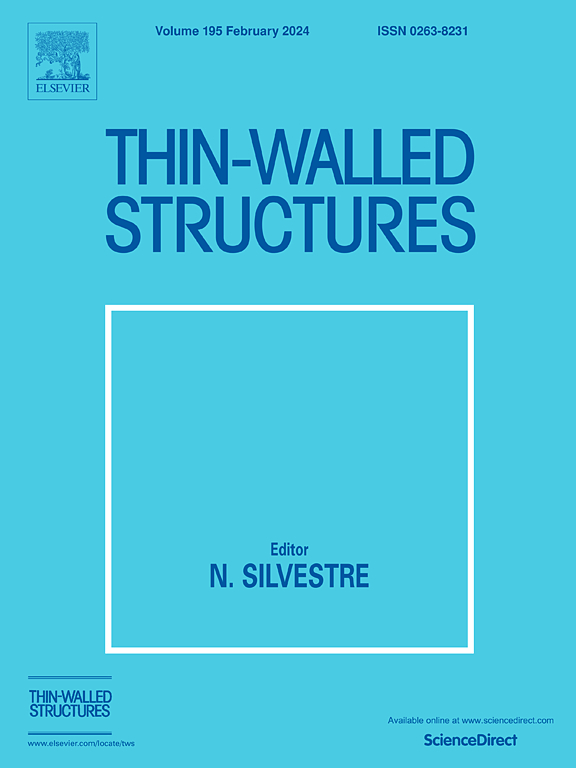Creep behaviour and modelling of adhesively bonded CFRP-steel joints
IF 5.7
1区 工程技术
Q1 ENGINEERING, CIVIL
引用次数: 0
Abstract
The performance of adhesively bonded joints is vital to the effectiveness of carbon fibre-reinforced polymer (CFRP) strengthening in steel structures. This study investigates the creep of CFRP-steel joints employing a combination of experimental testing and numerical analysis. A total of 10 characterisation tests were conducted on the strengthening adhesive to assess its thermal stability and viscoelastic creep properties. The findings revealed a significant increase in the creep rate as the temperature approached the adhesive's glass transition temperature (63.9 °C). Based on these results, a viscoelastic constitutive model, formulated using a Prony series, was developed and applied in the numerical analysis of the creep performance of CFRP-steel joints. Additionally, 6 sustained loading tests were performed on individual CFRP-steel joints, measuring creep displacement over periods of 7 and 12 days, which were used to validate the model's predictions. The experimental and numerical results showed a strong correlation, with a minimum R2 value of 0.883. Extended numerical simulations, encompassing 60 scenarios, demonstrated that increasing the adhesive layer thickness significantly influences creep displacement, while variations in bond length have a relatively minor effect. After 30 days, a joint with a bond length of 13.5 mm and an adhesive thickness of 3.0 mm was predicted to exhibit a creep displacement of 62.5 μm, emphasising the importance of accounting for creep in design. The numerical modelling method based on material characterisation can be applicable for studying creep in various engineering adhesively bonded joints and offers valuable insights for optimising CFRP-steel joint designs in practical applications.
粘接接头的性能对于碳纤维增强聚合物(CFRP)在钢结构中的加固效果至关重要。本研究采用实验测试和数值分析相结合的方法,对碳纤维增强聚合物-钢接头的蠕变进行了研究。总共对加固粘合剂进行了 10 次表征测试,以评估其热稳定性和粘弹性蠕变特性。测试结果表明,当温度接近粘合剂的玻璃转化温度(63.9 °C)时,蠕变率明显增加。在这些结果的基础上,开发了一个使用 Prony 系列制定的粘弹性构成模型,并将其应用于 CFRP-钢接头蠕变性能的数值分析。此外,还对单个 CFRP 钢接头进行了 6 次持续加载试验,测量了 7 天和 12 天的蠕变位移,用于验证模型的预测结果。实验和数值结果显示出很强的相关性,最小 R2 值为 0.883。包含 60 种情况的扩展数值模拟表明,增加粘合剂层厚度对蠕变位移有显著影响,而粘合剂长度的变化影响相对较小。30 天后,粘合长度为 13.5 毫米、粘合剂厚度为 3.0 毫米的接头预计会出现 62.5 μm 的蠕变位移,这强调了在设计中考虑蠕变的重要性。基于材料表征的数值建模方法可用于研究各种工程粘合接头的蠕变,并为优化实际应用中的 CFRP 钢接头设计提供宝贵的见解。
本文章由计算机程序翻译,如有差异,请以英文原文为准。
求助全文
约1分钟内获得全文
求助全文
来源期刊

Thin-Walled Structures
工程技术-工程:土木
CiteScore
9.60
自引率
20.30%
发文量
801
审稿时长
66 days
期刊介绍:
Thin-walled structures comprises an important and growing proportion of engineering construction with areas of application becoming increasingly diverse, ranging from aircraft, bridges, ships and oil rigs to storage vessels, industrial buildings and warehouses.
Many factors, including cost and weight economy, new materials and processes and the growth of powerful methods of analysis have contributed to this growth, and led to the need for a journal which concentrates specifically on structures in which problems arise due to the thinness of the walls. This field includes cold– formed sections, plate and shell structures, reinforced plastics structures and aluminium structures, and is of importance in many branches of engineering.
The primary criterion for consideration of papers in Thin–Walled Structures is that they must be concerned with thin–walled structures or the basic problems inherent in thin–walled structures. Provided this criterion is satisfied no restriction is placed on the type of construction, material or field of application. Papers on theory, experiment, design, etc., are published and it is expected that many papers will contain aspects of all three.
 求助内容:
求助内容: 应助结果提醒方式:
应助结果提醒方式:


